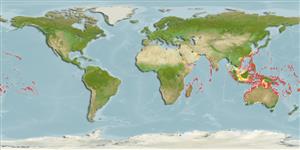Classification / Names
Common names from other countries
Main reference
Size / Weight / Age
Max length : 90.0 cm SL male/unsexed; (Ref. 4319); common length : 90.0 cm TL male/unsexed; (Ref. 5450)
Length at first maturity
Lm ?, range 58 - ? cm
Environment
Marine; reef-associated; oceanodromous (Ref. 51243); depth range 1 - 46 m (Ref. 9710)
Climate / Range
Tropical, preferred 27°C (Ref. 107945); 30°N - 34°S, 27°E - 134°W (Ref. 5222)
Distribution
Indo-Pacific: Red Sea and east coast of Africa to French Polynesia. In the western Pacific it ranges from southern Japan to southern Queensland and Lord Howe Island. Often confused with Epinephelus fuscoguttatus.
Countries | FAO areas | Ecosystems | Occurrences | Introductions
Short description
Dorsal
spines
(total): 11;
Dorsal
soft rays
(total): 14-15;
Anal
spines: 3;
Anal
soft rays: 8. Distinguished by the following characteristics: pale brown color; head, body and fins covered by numerous small dark brown spots; whitish upper half of body with large irregular dark blotches and dark saddle on upper tail base; body scales ctenoid in broad zone on side from beneath pectoral fin to caudal peduncle, cycloid elsewhere; body with auxiliary scales; greatest depth of body 2.7-3.1 in SL; rounded caudal fin; short pelvic fins, 1.9-2.4 in head length (Ref. 90102); head length 2.3-2.5 times in SL; flat interorbital area, evenly convex dorsal head profile; rounded preopercle, serrae at angle slightly enlarged; very convex upper edge of operculum; posterior nostril diameter about twice diameter of anterior nostrils; maxilla reaches to or beyond vertical at rear edge of eye; 2-3 rows of teeth on midlateral part of lower jaw; front of jaws with inconspicuous fixed canines (Ref. 89707).
IUCN Red List Status (Ref. 115185)
Threat to humans
Reports of ciguatera poisoning (Ref. 1602)
Human uses
Fisheries: commercial; aquaculture: experimental
More information
ReferencesAquacultureAquaculture profileStrainsGeneticsAllele frequenciesHeritabilityDiseasesProcessingMass conversion
Tools
Special reports
Download XML
Internet sources
Estimates of some properties based on models
Phylogenetic diversity index
PD50 = 0.5000 many relatives (e.g. carps) 0.5 - 2.0 few relatives (e.g. lungfishes)
Trophic Level
4.0 ±0.5 se; Based on diet studies.
Resilience
Medium, minimum population doubling time 1.4 - 4.4 years (Preliminary K or Fecundity.)
Vulnerability
Moderate to high vulnerability (52 of 100)
Price category
